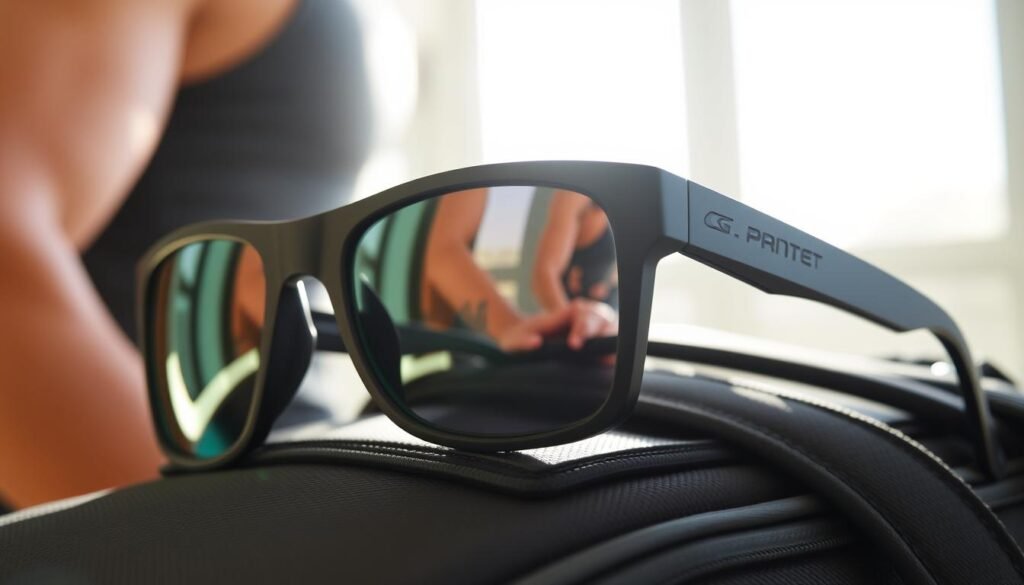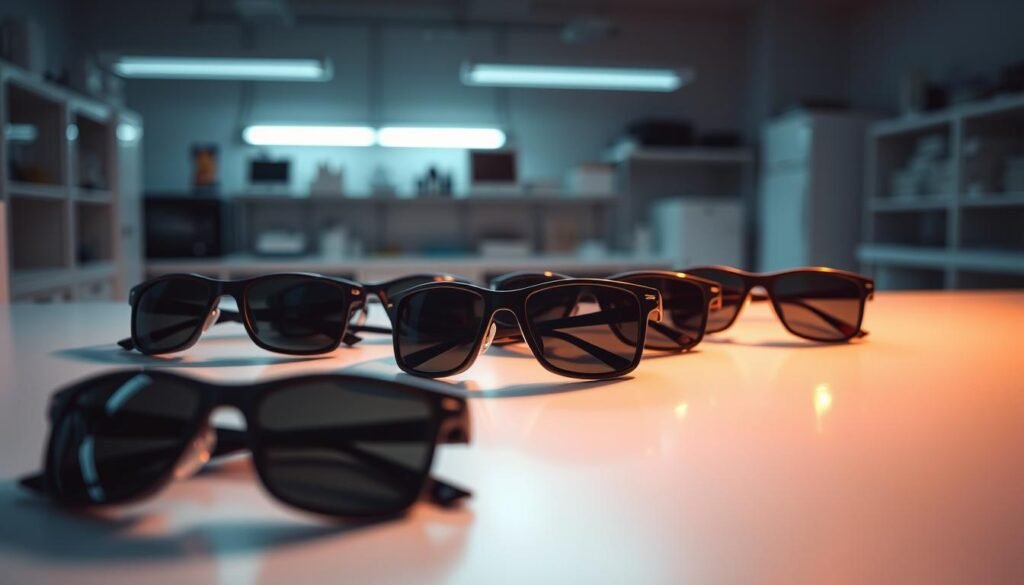Polarized lenses are praised for blocking glare and UV rays, especially near water or roads. Many assume they’re the ultimate choice for sunny days. But even top-tier tech has trade-offs.
These specialized lenses filter horizontal light to reduce eye strain. However, this same feature can distort screens on phones, dashboards, or ATMs. For pilots or skiers, that blur could become a safety risk.
Cost is another factor. Polarized options often cost 20-50% more than standard UV-blocking eyewear. While they excel in bright settings, they’re less versatile in low-light conditions. Hikers, for example, might miss subtle ice patches without natural glare cues.
Even daily tasks like reading LCD screens can feel awkward. The filters sometimes clash with tinted windows, creating odd visual effects. For some, the “always better” myth fades when real-life limitations appear.
Key Takeaways
- Polarized lenses may distort digital screens and LCD displays.
- Higher price tags compared to regular UV-protective eyewear.
- Can reduce visibility of icy surfaces or reflective hazards.
- Not ideal for low-light environments or certain tech-heavy jobs.
- Might interfere with car window tints or anti-glare coatings.
Overview of Polarized Sunglasses
Ever wonder how some sunglasses magically erase blinding reflections? The secret lies in their layered design. These specialized glasses use a chemical film that acts like microscopic blinds, filtering light waves to improve clarity.
How Polarized Lenses Work
The magic happens through a vertical filter embedded in the lens. This layer blocks horizontal light waves bouncing off flat surfaces like lakes or highways. By neutralizing these intense glares, your eyes perceive colors more vividly and details more sharply.
Standard UV-blocking glasses simply darken your view. Polarized versions actively reorganize light patterns. This makes them exceptionally effective for activities like fishing or driving, where water or pavement reflections dominate.
Comparing Benefits and Drawbacks
While these lenses excel in bright conditions, they’re not perfect for every scenario. Their glare-fighting superpower can backfire with digital screens. Phone displays might appear washed out or completely blacked out at certain angles.
Non-polarized options often handle mixed lighting better. They’re usually cheaper too. Think of polarized glasses as specialists – unbeatable for sunny days on the water, but less adaptable for twilight hikes or tech-heavy tasks.
Everyday Negatives: Digital Screens and Low Light Challenges
Have you ever tilted your head sideways just to read your phone screen while wearing shades? That awkward dance happens because polarized lenses and modern tech don’t always play nice. Let’s break down two common headaches users face.

Issues with LCD Screens and Digital Displays
Your smartphone’s screen might look like a dark void through polarized glasses. Why? LCD screens emit light waves that clash with the lens filters. This battle of polarizers can:
- Wash out GPS navigation displays
- Create rainbow patterns on car dashboards
- Hide critical info on fitness trackers
Photographers often ditch these lenses during shoots. “I’ve missed crucial shots because my camera screen looked pitch-black,” says pro shooter Mark Trewin. Drivers face similar risks when dashboard warnings become invisible.
Reduced Visibility in Low-Light Conditions
While regular sunglasses adapt to changing light, polarized versions stay dark. This creates problems during:
| Situation | Polarized | Non-Polarized |
|---|---|---|
| Dawn commutes | Road signs harder to see | Clearer visibility |
| Evening hikes | Muted trail details | Better contrast |
| Cloudy days | Overly dim view | Balanced lighting |
The filter that blocks glare also steals precious light. Cyclists might miss potholes at twilight, while boaters could overlook floating debris. Sometimes, seeing less isn’t better.
Dissecting the negatives of polarized sunglasses in Active Lifestyles
For thrill-seekers and athletes, visual clarity can mean the difference between victory and disaster. Specialized eyewear that alters depth perception or masks terrain details might compromise safety during critical moments.

Visual Challenges in High-Stakes Activities
Some wearers report dizziness when depth perception shifts unexpectedly. Skiers racing down slopes might miss subtle ice patches blending into snowy backgrounds. “I thought the trail was smooth until I hit a frozen ripple,” shares competitive skier Jenna Corwin. “My lenses flattened everything into a white sheet.”
Ball sports demand precise depth judgment too. Baseball players tracking fly balls or tennis players gauging serves could misjudge trajectories. Motorcyclists face similar risks – road oil slicks or gravel patches become nearly invisible without natural glare cues.
- Airline pilots avoid these lenses due to instrument panel distortions
- Construction equipment operators need unfiltered surface views
- Whitewater kayakers struggle to read water textures
Style and Budget Constraints
While grey and brown tints dominate the market, vibrant options remain scarce. Compare popular choices:
| Feature | Polarized | Standard |
|---|---|---|
| Average Cost | $150+ | $120 |
| Tint Options | 3-5 | 15+ |
| Car Windshield Clarity | Rainbow artifacts | Clear view |
Drivers often notice strange grid patterns on windshields, while fashion-focused users lament limited color coordination. For those needing both UV protection and budget flexibility, non-polarized alternatives frequently deliver better value.
Conclusion
Choosing the right eyewear depends on your daily needs and activities. Polarized lenses shine in bright settings like water sports or long drives, where reducing glare improves comfort. But these specialized filters aren’t a “one-size-fits-all” solution.
Consider standard UV400 glasses if you need consistent visibility. They handle LCD screens better and adapt to changing light without the 25% price bump. Outdoor enthusiasts might prefer them for twilight hikes or snowy trails where natural glare signals hidden ice.
Before buying, test how lenses interact with your phone and car dashboard. Tilt your head to check for screen blackouts or rainbow patterns. If you experience dizziness or struggle with low-light clarity, non-polarized options offer similar UV protection without visual trade-offs.
Your lifestyle decides the winner. Boat captains and anglers benefit most from glare-cutting tech. For everyday use or mixed conditions? A quality pair of standard sunglasses often delivers better versatility and value.

